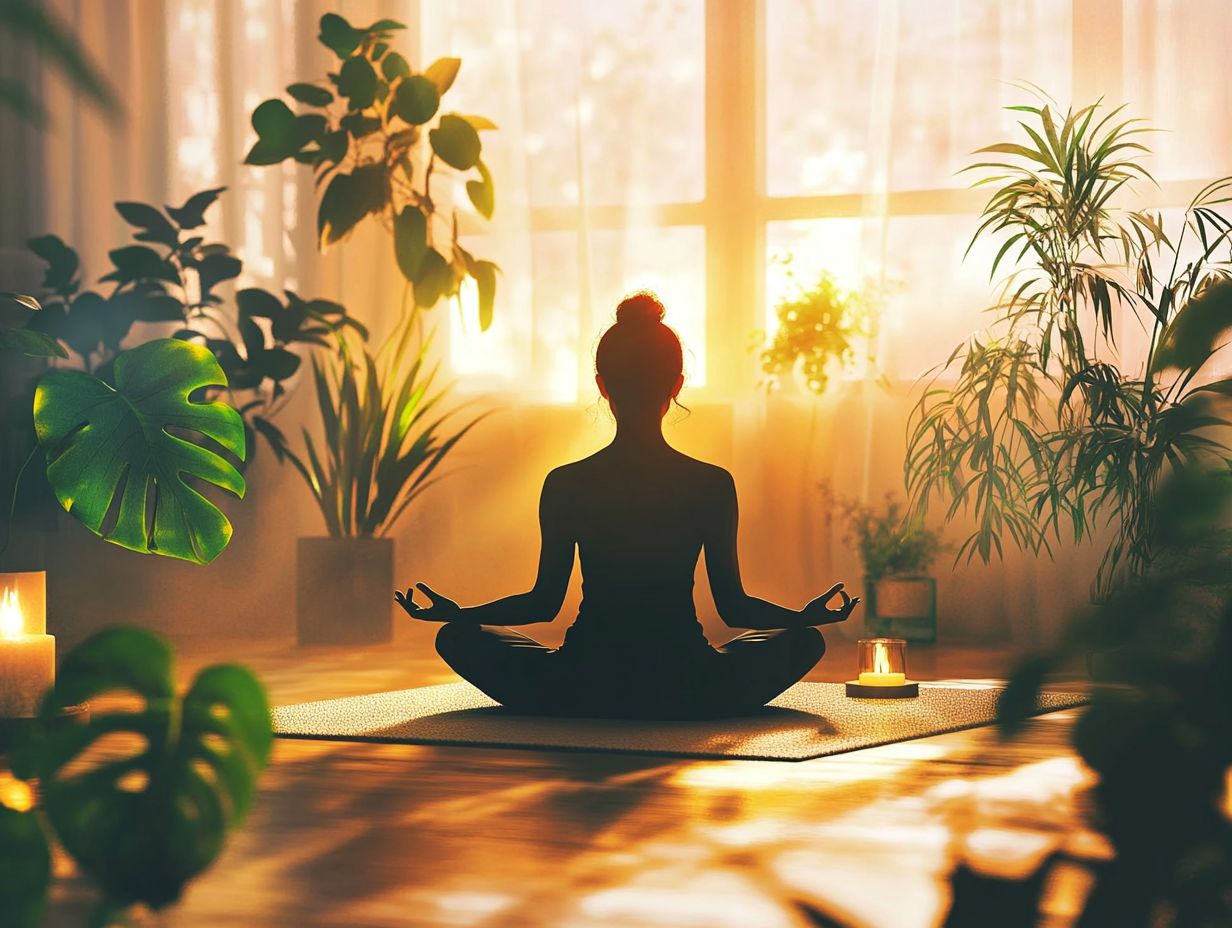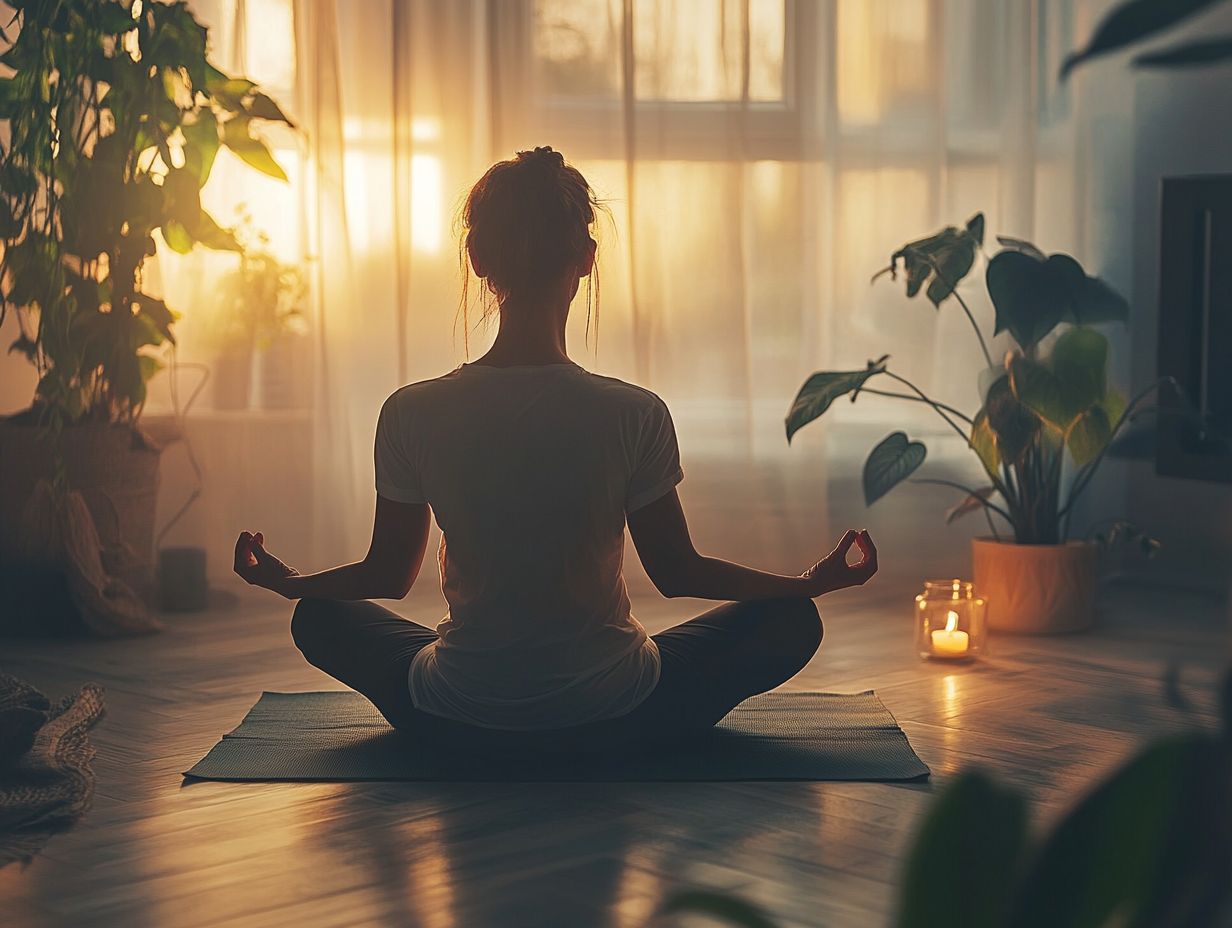10 Tips for Successful Mindfulness Meditation
Mindfulness meditation is a transformative practice that can elevate your daily life, helping you think clearly, feel calm, and build emotional resilience.
If you re eager to enhance your experience or start a new journey, this article offers ten essential tips to guide you. From creating a welcoming space to exploring various techniques, each suggestion will empower you to deepen your meditation practice.
You ll explore the benefits, tackle common challenges, and learn how to seamlessly weave mindfulness into your everyday routine.
Immerse yourself and uncover how these straightforward strategies can lead to profound changes in your life.
Contents
- Key Takeaways:
- 1. Find a Quiet and Comfortable Place
- 2. Set a Timer
- 3. Sit in a Comfortable Position
- 4. Focus on Your Breathing
- 5. Acknowledge and Let Go of Thoughts
- 6. Use a Mantra or Affirmation
- 7. Practice Gratitude
- 8. Be Patient and Persistent
- 9. Start with Short Sessions and Gradually Increase Time
- 10. Dive into Guided Meditations!
- How Can Mindfulness Meditation Benefit Your Life?
- Got Questions? We ve Got Answers!
- What is mindfulness meditation and why is it important?
- What are the 10 tips for successful mindfulness meditation?
- How long should I meditate for?
- What should I do if my mind starts to wander during meditation?
- Can I practice mindfulness meditation anywhere?
- How can I incorporate mindfulness into my daily life?
Key Takeaways:

- Find a quiet, comfortable spot and set a timer for your meditation practice.
- Focus on your breathing, acknowledge and let go of thoughts, and use a mantra or affirmation to guide your practice.
- Be patient and persistent. Start with short sessions and gradually increase the time. Listen to guided meditations to enhance your mindfulness practice.
1. Find a Quiet and Comfortable Place
Finding a quiet and comfortable place is crucial for establishing a successful mindfulness practice. It creates an environment that enhances your meditation and emotional awareness, ultimately boosting your mental health and relaxation.
A calm setting can truly transform your meditation experience, making it easier for you to focus, practice gratitude, and manage your energy effectively throughout the day.
When selecting your ideal space, choose locations that are free from interruptions and noise perhaps a cozy nook in your home or a tranquil outdoor area.
The comfort of your seating choice, whether it s a cushion, chair, or floor mat, profoundly impacts the quality of your practice, allowing you to stay relaxed yet alert.
Consider incorporating soft lighting, soothing colors, and natural elements to further enhance the ambiance and foster a deeper emotional connection. A serene environment not only aids in stress relief but also encourages a more profound awareness of your thoughts and feelings, paving the way for a transformative meditation journey.
2. Set a Timer
Setting a timer for your meditation session is essential for cultivating a consistent practice. It allows you to dive deep into the experience without the constant urge to check the clock.
When you allocate a specific amount of time for each meditation, you establish a routine that helps you stick to your practice. This structured approach amplifies the effectiveness of your meditation and reinforces the significance of mindfulness in your daily life.
As you develop the habit of taking regular mindfulness breaks, you’ll notice remarkable improvements in your focus and stress relief. These little retreats offer a refreshing pause amid the chaos, giving your mind the chance to reset and rejuvenate, ultimately boosting your productivity and enhancing your emotional well-being.
3. Sit in a Comfortable Position
Sitting comfortably is crucial for your meditation practice, as it creates an atmosphere of stillness and focus, allowing you to immerse yourself fully in mindfulness without the distraction of physical discomfort.
Practicing meditation in various positions, whether cross-legged on the floor or upright in a chair, invites deeper relaxation and fosters a stronger connection with yourself. Proper posture is essential, especially during techniques like body scans, where your mind methodically navigates through different body parts.
By maintaining an aligned spine and relaxed shoulders, you enhance blood circulation and promote emotional acceptance. When your body feels at ease, it naturally helps release tension, paving the way for a more enriching meditation experience.
This comfort nurtures an environment where your thoughts and feelings can be acknowledged without judgment, allowing for a truly transformative practice.
Don’t wait to discover the benefits of mindfulness begin your journey now!
4. Focus on Your Breathing
Focusing on your breathing is a fundamental aspect of meditation. It serves as your anchor to cultivate stillness and mindfulness. This practice reduces stress and enhances your emotional awareness.
Techniques like deep belly breathing and the 4-7-8 method invite you to fully immerse yourself in your breath. They promote both relaxation and clarity of thought.
By weaving these breathing exercises into your daily routine, you create a personal breathing space a moment entirely free from distractions. This practice is essential for emotional regulation and fosters creative expression. A calm mind is often more receptive to new ideas.
Whether you find rhythm in the flow of your inhales and exhales or embrace the intentional pauses between breaths, these techniques can unlock your latent creativity. They also offer a sanctuary for emotional balance.
5. Acknowledge and Let Go of Thoughts
Acknowledging and letting go of thoughts is crucial in mindfulness meditation. This practice fosters an accepting approach on your awareness journey, significantly enhancing your emotional regulation and mental well-being.
Instead of viewing your thoughts as permanent residents in your mind, embrace them as temporary visitors. Cultivating an attitude of acceptance creates a safe space where intrusive thoughts can transform from sources of distress into opportunities for self-reflection.
Simple techniques like focusing on your breath, visualizing thoughts as clouds drifting across the sky, or gently redirecting your attention to physical sensations can facilitate this process.
Each time you release unhelpful thoughts, you reinforce a foundation of self-kindness. This gradually deepens your understanding of your emotional landscape.
6. Use a Mantra or Affirmation

Try using a mantra or affirmation during meditation to supercharge your practice! It serves as a focal point that enhances your emotional connection and mindfulness, amplifying the core benefits of meditation.
How do you choose the right mantra? It should resonate with you personally, evoke positive emotions, and align with your intentions. This resonance deepens your engagement and allows you to fully immerse yourself in positive thinking.
As you repeat your mantra, it creates a soothing rhythm that helps quiet your mind and promotes relaxation. This makes it easier to let go of stress. By focusing on the affirmation, you not only reinforce a sense of peace but also nurture self-compassion. This transforms your meditation experience into a powerful tool for emotional and mental well-being.
7. Practice Gratitude
Incorporating gratitude into your meditation routine enhances your emotional awareness. It also serves as a vital self-care practice that nurtures your mental health and well-being.
By honing in on the positive aspects of life during meditation, you cultivate a deeper emotional connection with yourself and the world around you. This practice significantly influences your daily routines, fostering a mindset of appreciation. It makes it easier to navigate challenges with resilience.
When you weave gratitude into your meditation, even a brief session can transform into a moment of reflection. This promotes mindfulness and encourages a more compassionate outlook.
Start your meditation with gratitude today! Notice how this simple change can transform your day. Over time, this intentional focus on thankfulness can lead to stronger relationships and a greater sense of inner peace. It enriches both your personal journey and the experiences you share with others.
8. Be Patient and Persistent
Being patient and persistent in your meditation practice is essential for unlocking long-term benefits. It allows you to cultivate a sense of stillness and resilience as you navigate the inevitable challenges that life throws your way.
This journey of self-discovery invites you to embrace moments of discomfort and distraction. Recognize them as natural stepping stones in your growth.
Developing the habit of taking regular mindfulness breaks can significantly enhance your focus and emotional regulation. Simple techniques, like deep breathing, can be powerful tools for grounding yourself during hectic times. They create small pockets of calm throughout your day.
As you integrate these practices, you might discover that even brief moments of mindfulness can transform your emotional responses. This fosters a deeper connection to the present and equips you with more effective coping strategies during challenging moments.
9. Start with Short Sessions and Gradually Increase Time
Begin with brief meditation sessions and gradually extend their duration. This makes the practice feel more approachable and lays a solid foundation for your mindfulness journey and self-care.
By dedicating just a few minutes each day, you can feel more comfortable, easing the intimidation often associated with forming a new habit.
As your confidence grows, extending these sessions will feel like a natural progression, allowing for deeper engagement with the practice.
This gradual increase builds persistence and boosts your mental clarity, emotional regulation, and overall well-being.
Over time, integrating meditation into your daily routine can lead to reduced anxiety, improved focus, and greater emotional balance. It becomes an invaluable tool for maintaining your mental health and resilience.
10. Dive into Guided Meditations!
Guided meditations are a fantastic way to enhance your practice, whether you re a beginner or experienced.
These sessions offer structured relaxation techniques that help you develop deeper awareness and emotional connection.
With professional guidance, you can navigate your thoughts and feelings more easily, leading to improved focus and emotional regulation.
Incorporating regular guided meditation into your daily routine can create a lasting habit that promotes mindfulness in your everyday life.
If you’re interested in exploring this further, platforms like Headspace offer a wealth of reputable courses tailored to various skill levels. You’ll find a pathway that resonates with your personal journey.
How Can Mindfulness Meditation Benefit Your Life?
Mindfulness meditation brings a wealth of benefits that can significantly enhance your life, from improved mental health to greater emotional awareness and effective self-care practices that alleviate stress and anxiety.
Spending just a few minutes each day on this practice can help you cultivate a deeper sense of presence and tranquility. Mindfulness quells the chaos of daily life, creating space for personal growth and enabling you to form deeper emotional connections.
Taking mindful breaks can be a game-changer for your creativity. Simply stepping away from a task to breathe deeply or observe your surroundings can refresh your mind and spark innovative ideas.
Techniques like breathing exercises or brief meditative walks help you reconnect with your inner self. They ultimately foster a sense of peace and holistic well-being that aligns with a healthier lifestyle.
What Are the Different Types of Mindfulness Meditation?

You ll discover a variety of mindfulness meditation styles, each offering unique focuses and techniques, ranging from body scans to visualization methods and even mindful eating.
This diversity allows you to tailor your practice to meet your specific needs.
Selecting the right style can profoundly impact your journey toward emotional acceptance. For example, body scan meditation which involves focusing attention on different body parts can deepen your relaxation.
Conversely, visualization techniques open the door to imaginative exploration, especially useful for those seeking inspiration or tranquility.
Mindful eating centers around the sensory experience of food, cultivating gratitude and awareness in your daily life.
By exploring these different approaches, you can choose a method that resonates with your emotional landscape, guiding you toward a more accepting relationship with yourself.
How Can You Incorporate Mindfulness into Your Daily Life?
Incorporating mindfulness into your daily life is easier than you might think! Simple practices can promote awareness, such as taking mindfulness breaks, practicing mindful breathing where you pay attention to your breath and integrating self-kindness exercises into your routine.
These mindful moments don t need to take much time; even a few minutes can create a significant impact. Consider setting reminders throughout your day as an invitation to pause, take a deep breath, and tune into your body s sensations and the present moment.
Engaging in these practices consistently enhances your emotional resilience and cultivates a deeper sense of peace and clarity. By managing your energy effectively and intentionally carving out space for mindfulness, you foster a mindset that prioritizes mental well-being, ultimately enabling a more balanced and fulfilling life.
What Are the Common Challenges of Mindfulness Meditation?
Common challenges in mindfulness meditation often include grappling with discomfort, distractions, and that all-too-human tendency to judge yourself all of which can impede your awareness journey.
These obstacles frequently surface when you sit in stillness, drawing your attention to both physical sensations and fleeting thoughts. Discomfort may show up as restlessness or pain, prompting you to question your ability to meditate effectively. Similarly, distractions, whether external noises or the internal chatter of your mind, can divert your focus from the present moment, leaving you feeling frustrated.
Perhaps most critically, the urge to evaluate your performance can create a barrier, hindering a genuine connection with your experience. Acknowledging these challenges with a nonjudgmental mindset is essential. This approach allows you to practice with compassion, transforming hurdles into valuable opportunities for growth.
How Can You Overcome These Challenges?
Overcoming common challenges in mindfulness meditation requires patience, practice, self-compassion, and the strategic use of resources like an accountability partner to help you navigate difficulties.
Remember, every meditator, regardless of their experience level, faces hurdles along their journey.
Incorporate regular practices that nurture patience like deep breathing exercises or guided sessions to gradually enhance your focus. Seek support from friends or join meditation groups to create an encouraging atmosphere where sharing experiences can lead to breakthroughs.
Maintaining motivation often involves setting small, achievable goals and celebrating your progress, no matter how minor it may seem. This approach fosters resilience and transforms meditation into a more fulfilling and rewarding practice.
What Are the Long-Term Effects of Regular Mindfulness Meditation?
Regular mindfulness meditation can profoundly impact your mental health over time, leading to better emotional regulation, reduced stress levels, and a more vibrant expression of creativity.
Numerous studies reveal that those who practice mindfulness often undergo a significant transformation in their overall outlook on life, fostering a deeper sense of awareness and presence.
Experts emphasize that engaging consistently in mindfulness builds resilience against anxiety and depression while sharpening cognitive functions, enhancing your focus and memory.
For instance, research published in Psychological Science shows that individuals who meditate regularly report higher life satisfaction and emotional stability, showcasing the extensive benefits of mindfulness for your well-being.
Embracing this practice can be truly transformative, enriching various facets of your mental health and promoting a more balanced and fulfilling life.
Got Questions? We ve Got Answers!
What is mindfulness meditation and why is it important?

Mindfulness meditation is a practice that involves focusing your mind on the present moment and being aware of your thoughts, feelings, and surroundings without judgment. It s important because it can help reduce stress, improve mental and physical health, and increase overall well-being.
What are the 10 tips for successful mindfulness meditation?
Let s dive into these essential tips that can transform your meditation practice!
- Find a comfortable, quiet place to meditate.
- Set aside specific time for meditation.
- Try various techniques to find what suits you.
- Focus on your breath.
- Be patient and kind to yourself.
- Let go of expectations.
- Use guided sessions led by an instructor or an app.
- Avoid distractions.
- Practice regularly.
- Stay open to the experience.
How long should I meditate for?
Start with 5 to 10 minutes of meditation and gradually increase the duration as you become more comfortable with the practice. Some people meditate for 20 to 30 minutes, while others may meditate for an hour or more. Ultimately, the length of your meditation session should depend on your personal preference and schedule.
What should I do if my mind starts to wander during meditation?
If this happens, just acknowledge the thought and gently redirect your focus back to your breath or your chosen anchor. Do not get frustrated or judge yourself, as this is a natural part of the practice.
Can I practice mindfulness meditation anywhere?
Yes, you can practice mindfulness meditation anywhere as long as you can find a quiet and comfortable space. However, having a dedicated meditation area can help create a peaceful and calming atmosphere for your practice.
How can I incorporate mindfulness into my daily life?
You can incorporate mindfulness into your daily life by being present and aware in your activities, such as eating, walking, or doing household chores. Also, practice short mindfulness exercises throughout the day, like taking a few deep breaths or noticing your surroundings.
Start practicing these tips today and embrace the calming journey of mindfulness meditation!






